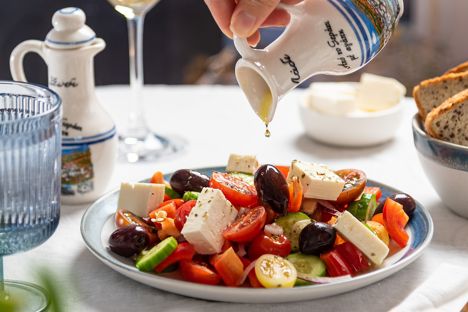
The essential Greek store cupboard ingredients
Greek cooking is unfussy and relaxed, rooted in fresh ingredients which are always found locally. It’s also simple to recreate at home – here are the ingredients you’ll need to get started.
We might associate Greek food with smoky, charred souvlaki, fall-apart lamb kleftiko or baked moussaka, but most of its day-to-day dishes are actually vegetarian. Not only do Greek cooks use an abundance of vegetables, from aubergines and courgettes to onion, but they also give them the attention they deserve, elevating dishes we might enjoy as sides to the main event. And where meat is served, it’s often used sparingly, still coming second to other produce. Though the cuisines shift slightly as you travel around Greece (we’ve focused on Cretan cooking in this guide here), they are bound together by a focus on what’s nearby – native legumes and vegetables, for example, and pantry staples like olive oil and honey.
Most Greek recipes aren’t overly complex; instead, they take a few ingredients and let those flavours burst through. Its recipes are filled with the fragrance of herbs including oregano and thyme, the citrusy tang of lemon or the complexity of Greek olive oil, a cherished ingredient which is used to cook and finish both sweet and savoury dishes and can be traced back to ancient Greece. Ultimately, it’s unpretentious and hearty – and simple to replicate at home. You can browse our collection of Greek recipes here, but before you get going, here are the store cupboard essentials you’ll need.
Olive oil
Ancient Greeks were among the first to produce and use olive oil, a deep-rooted connection that has put it at the heart of Greek culture thanks to both its medicinal and culinary qualities. It has consistently been a part of the Greek diet, and has been an essential source of calories and nutrients even during times of hardship. Today, Greek extra virgin olive oil is exported around the world, but remains as prized at home, used in almost every dish that ends up on the dinner table, including lathera, a term which simply means vegetables simmered in olive oil (our fasolakia, green bean stew, is a great example). It’s mixed into salad dressings and marinades, brushed onto grilled food, rubbed onto meats before they are roasted, used in satuéing and pan-frying and, of course, drizzled on salads, finished dishes and ingredients like tomatoes.
It’s fair to say that olive oil is intrinsic to Greek life. It’s a message that olive oil producer GAEA is keen to spread; their goal is to encourage us all to take a slice of the Greek mindset when it comes to food; focusing on quality, simple food and drink that brings loved ones together. Their fantastic extra virgin olive oils range from earthy and grassy to fruity and aromatic, and are always made from hand-picked, organically-grown olives.
Lemon
Lemon groves are dotted across most of Greece, so it’s no surprise the citrus fruit is widely used in its cooking. Lemon wedges and slices accompany most traditional meals, while the juice marinates grilled meats and adds zing to everything from roast potatoes to salads and rich braises like kleftiko. Greeks combine lemon with egg to make the classic silky avgolemonos sauce, which is then added to soups, pastas and stews. There’s also ladolemnono, a simple but staple extra virgin olive oil and lemon dressing used on salads and grilled meats and fish.
Greek oregano
Greek oregano – which has a more earthy flavour than other types – is used widely in Greek cooking in dried and fresh forms to add a savouriness to everything from meat and fish to cheese and egg. It’s so commonplace we’d struggle to list the dishes you can find it in here, but it’s used both during cooking and after to finish dishes, and has a starring role in the likes of kotopoulo riganato, grilled oregano and garlic-spiked chicken, and riganada, where crushed tomato and oregano are spread on toasted bread (similar to Cretan dakos or even Italian bruschetta).
Kalamata olives
Greece is home to an array of olives, from halkidiki to throuba, but the one that’s arguably its best-known is the Kalamata, which takes its name from the southern Greek city. Large, plump and fruity, they’re savoured as they are, but also tossed into salads (including its most famous Greek – or horiatiki – salad) or blended with herbs, lemon and garlic into pastes and tapenades. They’re also pressed into fantastic Greek olive oils.
Greek yoghurt
Typically thicker and creamier than regular yoghurt, Greek yoghurt is a staple ingredient in plenty of home kitchens. In Greece, it’s an accompaniment to everything from honey and nuts to fruit and meaty stews, and used in marinades to guarantee tender meat. It is of course the core element of Greek tzatziki, a refreshing cucumber, yoghurt-based dip made with garlic and olive oil which is often eaten alongside grilled meats and bread. Avgolemono sometimes includes a spoonful of yoghurt, and it’s baked into desserts including yoghurt cake yaourtopita.
Cucumber
Somewhat of an unsung hero, cucumbers are found at home in many Greek salads, often going hand in hand with tomatoes, olives and feta cheese. It’s also another crucial part of tzatziki, usually grated and squeezed to remove excess water, before being mixed with the other ingredients (you can see our recipe for tzatziki, which we’ve enjoyed with souvlaki, here).
Horta
Horta is the best example of Greek cuisine celebrating local produce – it’s a collective term for the wild greens found across the island, which locals head out to forage year round. Although they are weaved into various different recipes, including baked in pastries with feta and cheese, in its purest form, horta – which covers everything from wild arugula to chicory – is enjoyed gently boiled, before being served with just a drizzle of olive oil and lemon juice.
Feta cheese
Feta has become one of the most famous culinary exports of Greece, an ingredient completely synonymous with the country and so cherished it holds PDO status to guarantee its quality. A soft white cheese made from sheep’s milk (or a mixture of sheep and goat), it has a creamy texture with a tangy, salty flavour. It’s fantastic on its own, and is a staple in Greek salad (we've given it a twist and deep-fried it in our version above) and other cold dishes, but it’s also baked into Greek pastries – most notably with spinach in spanakopita, but also with aubergine in mpourekakia and manouri (another Greek cheese made from by-products of feta) in tyropitakia.
Honey
Honey has been made since the days of ancient Greece, celebrated for its medicinal, health and culinary benefits. Today, Greeks remain proud of their honey, which reflects the varied and diverse range of plants from which bees take their nectar (common types include pine and thyme honey). It’s weaved into sweet and savoury dishes; at breakfast, it’s drizzled onto yoghurt, stirred into tea or spread onto bread, while it’s also a go-to for baked treats, including syrupy baklava, Christmas honey cookies (melomakarona) and loukoumades, fried doughnuts which are soaked in honey. It’s not left out of savoury dishes, though, commonly adding sweetness to braised beef and lamb.
Filo dough
Paper thin and crispy, unleavened filo – or phyllo, meaning leaf, in Greek – is the pastry of choice in Greece. There are different varieties, including a thicker version and kataifi, a shredded variety, which are used to make Greece’s excellent pastries. Though the most famous include baklava and spanakopita, that’s only the tip of the iceberg – there’s the custard-filled galaktoboureko and bougasta; cheese and egg-based tiropita; and hortopita, which uses a mix of wild greens, among many others.
Tomato
Though tomatoes aren’t native to Greece, they are believed to have been brought to the country in the nineteenth century. It’s fair to say they’ve settled in nicely, now growing widely across the country and at home in countless recipes, including Greek salad and moussaka. Elsewhere, they’re crushed and spooned on top of rusks for dakos, fried into fritters in tomatokeftedes (try our recipe above), stuffed with rice and baked in gemista, combined with scrambled eggs and feta in brunch dish in strapatsada, braised in slow-cooks like kleftiko and adding depth of flavour to Greek tomato rice dish ntomatorizo.
Greek cooking’s mix of zesty, vibrant flavours, indulgent, flaky sweet treats and comforting braises create ever-beautiful combinations, underpinned by few ingredients more celebrated than its cherished olive oil.



